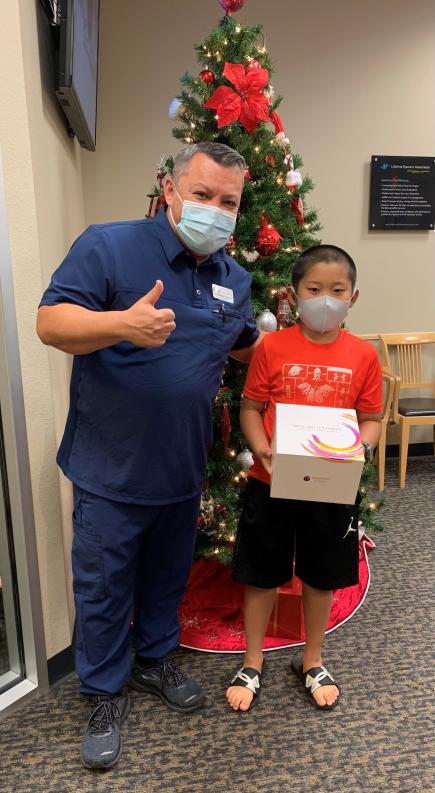Young children who are teetering on the edge of high myopia or have already crossed that threshold are at a heightened risk of developing certain eye diseases as they get older due to stretching from axial elongation1. This concern was central for optometrist Claudio Lagunas, who was recently keeping careful watch over his young high myopes on the cusp of needing a bump in their MiSight® 1 day prescription*, his preferred treatment for these children with myopia. Since these age-appropriate children were doing well with MiSight® 1 day, Dr. Lagunas, of Lifetime Eyecare Associates in The Woodlands, Texas, wanted to continue treatment; the age-appropriate kids were happy in the lenses, and their parents were pleased with the positive results.

Now, with CooperVision U.S.’s recent launch of expanded MiSight® 1 day lens parameters, many age-appropriate children with higher myopia prescriptions can remain in MiSight® treatment if they happen to require a prescription change. The expanded range—covering -0.50D to -7.00D—also means age-appropriate children with myopia above -6.00D will now be able to access MiSight®’s proven myopia control benefits 2*†.
“I can think of four or five children who started off at a -6.00, so they’re already at the end of the spectrum when it comes to parameters,” Dr. Lagunas says. “We knew that even though the lens does a great job, there could be a little progression because the children are say eight and nine years old and already a -6.00. Anything we can do to slow the process down, even if the age-appropriate child is already a high myope, will be beneficial3.”
Expanded Prescription Range Offers Continuity of Care
Parents trust their ECP and want to maintain their current prescribed treatment if their child is achieving good results, Dr. Lagunas explains. And higher prescriptions sometime mean a child will require more than one treatment, he adds. “Parents don’t want to hear that their child needs to change to a combo treatment and may possibly need drops as well,” Dr. Lagunas says. “The parent sees their child is happy with treatment and doing better in school. You can’t discount the emotional aspect. When the child is happy, the parent is happy, and when I’m happy with the results, we want to continue care. Having these expanded MiSight® parameters is critical for continuity of care for many age-appropriate children.”
MiSight® Provides Practice Growth Potential
Dr. Lagunas and his colleagues first got involved in myopia management roughly two years ago. At the time, Lifetime Eyecare Associates already had a busy contact lens practice, particularly with soft daily disposable lenses, so the MiSight®, with its strong science backing and FDA approval*, was a natural fit, Dr. Lagunas says.
Two-plus years later, Dr. Lagunas continues to see strong growth in the myopia management part of his practice, which he attributes to internal marketing efforts aimed at existing age-appropriate patients and their families. “We already have the patient base. The [age-appropriate] children are already there, many of their older siblings are in contact lenses, and some of the parents are highly nearsighted,” Dr. Lagunas says.
Plant the Myopia Management Seed Early
All the doctors at Lifetime Eyecare Associates are on board with myopia management and plant the myopia seed early during routine, annual pediatric eye exams. If a child has myopia or their prescription changes, Dr. Lagunas informs the parent that their child’s eye is growing faster than he’d like to see. If the parent isn’t yet ready to act on treatment, Dr. Lagunas will suggest the child return in six months (instead of a year) to monitor for any further changes in vision and axial length, which are expected until proven otherwise.
Sharing patient success stories can help an ECP’s marketing effort. For example, Dr. Lagunas recently saw two of his new MiSight® patients who had no change in their refractive status or axial length during their annual visit.4‡ “Previously, both their prescriptions were going up by about a diopter a year, and normally, we see some change,” Dr. Lagunas says.
Don’t Hesitate on Myopia Management
Dr. Lagunas, who also specializes in LASIK co-management, specialty contact lens fittings and dry eye treatment, believes eye doctors should embrace myopia management and not hesitate to take their first steps in this area. “MiSight® has made it super easy for doctors to jump on board the myopia management train and having the science behind the lens makes it very comforting for both the practitioners and the parents. Having the FDA approval* is huge,” he says.
Doctors don’t need additional technology to start, he explains. “You don’t have to measure axial length, although that can help. It’s very easy for practitioners to get in the game and start treating myopia.”
# # #
*Indications for Use: MiSight® 1 day (omafilcon A) soft (hydrophilic) contact lenses for daily wear are indicated for the correction of myopic ametropia and for slowing the progression of myopia in children with non-diseased eyes, who at the initiation of treatment are 8-12 years of age and have a refraction of -0.75 to -4.00 diopters(spherical equivalent) with ≤ 0.75 diopters of astigmatism. The lens is to be discarded after each removal.
†MiSight® 1 day covers 99.4% for US / European children* (who were initially fit between the ages 8-12) – who have myopia and less than 1D of astigmatism.
‡ Compared to single vision lens. -0.25D or less of change. Fitted at 8-12 years of age at initiation of treatment.
1. Wolffsohn JS, et al. Global trends in myopia management attitudes and strategies in clinical practice. Cont Lens Anterior Eye. 2016 Apr;39(2):106-16. doi: 10.1016/j.clae.2016.02.005.
2. CVI data on file, 2022. SERE coverage of childhood myopia prescriptions with MiSight® 1 day for 104,810 eyes in Asia (China, Korea) and 116,336 eyes in Europe and USA aged 8-18 years.
3. Tideman JW et al. Association of axial length with risk of uncorrectable visual impairment for Europeans with myopia. JAMA Ophthalmol. 2016;134:1355-1363.
4. Chamberlain P, et al. A 3-year Randomized Clinical Trial of MiSight® Lenses for Myopia Control. Optom Vis Sci. 2019; 96(8)556-567.








